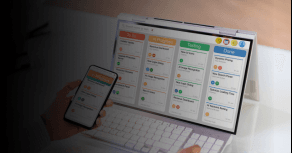Packaged solutions for every level of PPM maturity
Packaged solutions for every level of PPM maturity

Build an established book of work and optimize project management processes.
Vision

Establish optimal cost and resource management frameworks.
Vision

Optimize delivery and value attaining alignment with projects and strategic goals.
Vision
Value adds
Capabilities
Value adds
Capabilities
Value adds
Capabilities

We start by understanding the unique needs of life sciences organizations. Our experts assess key pain points, challenges, and opportunities to design a digitalization roadmap that integrates people, processes, and Microsoft technology for optimal success. Get expert insights to align business needs with Microsoft best practices and tailor Project Online to your goals.

Our PPM experts are well versed in rolling out Microsoft Project Online with Microsoft’s best practices. We also assist in licensing, purchase, and transition; we go one step further and help you determine the best licensing model. We also Guide and train your in-house team to ensure the end-users have the right support and guidance to use the solution successfully.

With deep expertise in both project management and the life sciences industry, we craft customized solutions tailored to your organization’s needs. Be itintegrating Project Online within your exiting workflows or customizing it to fit your business needs, we will guide you through the implementation process, ensuring a seamless transition with minimal disruption.

We understand the importance of a cohesive digital ecosystem. Our experts facilitate seamless integration of Project Online with other Microsoft tools such as SharePoint, Teams, and Power BI. This creates a unified environment that enhances collaboration and productivity.

Our commitment doesn’t end with implementation. We continuously monitor and optimize Project Online to align with evolving project needs. Our dedicated support team provides ongoing assistance, ensuring your organization maximizes the benefits of this powerful tool.

Project Online delivers insights into resource utilization, enabling efficient project execution and informed resource management in one platform. Power BI provides robust reporting, including Program Dashboards, Clinical and Tox Studies, Objectives, and KPIs, offering real-time insights into progress and risk assessment for informed decision-making. i2e specializes in creating reporting packages that integrate Project Online and Power BI, enhancing project analysis efficiency and depth.

With extensive domain expertise and a proven track record in partnering with pharmaceutical organizations, we developed the R&D PPM Framework using Microsoft Project Online. This framework streamlines project oversight by integrating planning, execution, and monitoring tools. For clinical studies, it supports trial planning, patient screening, resource management, and execution. It also features Resource Demand Forecasting, Capacity Planning, and advanced reporting through Microsoft Power BI, providing real-time insights and detailed dashboards for programs, clinical and tox studies, patient screening, and enrolment tracking.

Project Structures: How to establish with Planview, Planisware, and Project Online
From a pharmaceutical R&D context, project structures can be seen as a reliable process to organize, track, and deliver the tasks while keeping the stakeholders informed. If you don’t have a well-planned project structure: Portfolio decisions usually suffer from low visibilityTeams start losing alignmentMissing critical deadlines become normal With a strong project structure, key decision-makers can: Have a clear view throughout the entire pipelineEasily prioritize high-value portfolio assets Manage risks more efficiently Project portfolio management tools like Planisware, MS Project Online, and Planview help establish organized structures that accelerate pharma projects, ensure compliance and success. That said, let’s dive into what project structures mean in pharmaceutical context, and how these tools help establish them seamlessly. Types of project structures in pharmaceutical R&DSelecting the right structure is your first step to ensure on-time project delivery with the right resources, without bleeding budgets. Here are three types of project structures to consider: 1. Functional structure As the name suggests, functional structure involves grouping all teams as per specialized functions – be it clinical, manufacturing, regulatory etc. In this model, the departmental head usually manages the team members, while coordinating the projects within functional silos.Functional structures are best for:Small-scale pharma companiesLimited cross-functional project needsWhat to look out for?On the flipside, these models are also known to create communication gaps and slow down decision-making in accelerated R&D settings. 2. Projectized structure In this model, the project manager has 100% authority over the research team and key resources, unlike the former. The PMOs assign their teams to specific projects, often outside their everyday functional roles.Projectized structures are best for:Large-scale pharmaceutical project management needstime-sensitive, high-priority, high flexibility research initiatives What to look out for?Unfortunately, this model can also cause resource duplication and higher costs, particularly when multiple projects are running at the same time. 3. Matrix structure (Best suited for Pharma)Last, but most importantly, the matrix structure brings the best of both functional and projectized structures under one umbrella. Here, teams report to both functional and project managers. This way, resources can be shared across different projects without compromising on functional supervision.Matrix structures are best for:Mid-to-large organizations juggling between numerous programsHigh operational continuity & innovation-led settingsWhat to look out for?Despite being the most common project structure in pharma R&D, it calls for strong communication and higher role clarity, to avoid conflicts or confusion. How to establish Pharma-specific structures using Planisware, Project Online and Planview?Designing and implementing project structures that suit the complex requirements of pharmaceutical R&D become easier with PPM tools. Users can configure project hierarchies, governance models, allocate resources efficiently and support decision-making at every phase. Here are your options and steps to do it:Tool #1: PlanviewFirst on our list, Planview is a major contender in terms of portfolio management and resource optimization. With a little upfront tailoring, its project templates can align well with pharma workflows.How to set up a project structure in Planview?Configure project types: label templates (for example, “Phase I asset”, “Platform”)Define swimlanes as per function (clinical, regulatory, manufacturing)Set up a clear stage-gate workflow in roadmap view with well-defined gatesAttach gate checklists and deliverables to each stageEnable demand/capacity views for cross-functional resource alignment Tool #2: PlaniswareThe Planisware project management tool is purpose-built for life sciences projects, and mirrors pharma R&D workflows like none other in this list. For example, it embeds stage gate logic at every level. The platform natively supports clinical/CMC deliverables, molecule hierarchies, as well as regulatory milestones. Here, teams can easily set up projects that map exactly to asset phases, while having total control over gates and finances.How to set up a project structure in Planisware?Create a project template with WBS (discovery, preclinical, phase 1/2/3)Embed gates after every single phase, linking back to the decision criteria and business case scorecardsAdd key deliverables (for example: IND, CMC dossiers, clinical trial authorizations)Link back the financial/resource modules to WBS for seamless budget/version trackingRoll up to portfolio to maintain proper visibility across molecules and indications Tool #3: Project OnlineLastly, Project Online is a great choice for schedule-level planning; it’s not entirely built around pharmaceutical project management structures in focus. Here, teams need to build everything from ground up. The good part, however? Integrating with Power BI, Teams, and Power Automate.How to set up a project structure in Project Online?Start by designing your custom project template Define tasks for regulatory deliverables and project milestonesTrigger notifications at gate milestones by integrating Power Automate Integrate Power BI to access customized dashboards aligned to R&D phases’ progressManage resources via PWA to assign functional roles How to choose the right tool for your project structure needs?More than chasing latest features, choose project portfolio management tools that fit your team’s needs the best. This means judging the tool by how well it aligns with your project structure, people, and strategic goals. Choose Planisware if you would:Manage a mid-to-large pharma/biotech firm with a complex R&D asset portfolioRequire built-in stage-gate models, modifiable for drug development lifecyclesNeed strong portfolio governance & what-if scenario planning at scaleUse Project Online if you would:Require a quick, at-budget tool for basic-level project scheduling/ trackingFocus on daily task management, instead of strong portfolio governanceNeed hassle-free, end-to-end automation integration (Teams, Power BI, Outlook) Go for Planview if you would:Be transitioning from project-level to portfolio-level strategy while scaling upWant to have strong resource demand vs. capacity modelling Need visualized roadmaps, high financial visibility, cross-functional planning etc. Key takeaways at a glanceProject structure informs smart portfolio decisions, points out risks early and surfaces resource conflicts Matrix project structure is the best-suited for pharma/biotech teams, as it comes with a mix of agility, governance, and resource efficiencyMore features don’t ensure success; choose your tool that best fits your team’s maturity level, complexity of portfolio assets, and other key indicators.Planisware project management tool is best for enterprise players with deep pipelines; Project Online suits mid-sized teams focused on scheduling; Planview is the go-to option for strategy-driven PMOsNeed help getting started? Let’s talk about how we can help. i2e Consulting brings 15+ years of PPM expertise. We’ve partnered with leading pharma organizations to establish fit-for-purpose project structures that drive clarity, speed, and smarter portfolio decisions. Connect with us – let’s build a project structure that accelerates your portfolio growth.

Project Online and Power BI- A Dynamic Duo for Making Reports That Matter
Is making reports taking up all your time? Or Are you still wondering the answers to questions such as ‘what is the project’s progress? Or ‘how much will this project cost the company after two years?’ then your business needs a digital makeover. Companies need applications that can quickly analyze huge data sets and come up with trends that can help in decision-making. This is where Project Online and Power BI come into play. In this blog, we will tell you about Microsoft Project Online and Power BI, and how they can become a game-changer for your business? These applications are powered by Microsoft, and i2e can help you with the implementation as well as migration of your existing projects. Are You Already Using Project Online? Along with being a magnificent project management application, Project Online is also a precious data source. Leverage it correctly and it can give a powerful start towards making meaningful reports. This is where Power BI can change the way you look at the data. But doesn’t Project Online come with a reporting module, then why should you integrate Power BI? This is a reasonable doubt, which many of our clients expressed. Read the next section to find out. Why Integrate Power BI to Project Online? Power BI is a reporting tool that can analyze data and convert it into meaningful metrics for the business. Yes, Project Online does generate reports, but if you need customized reports, along with actionable insights, and smart visuals, then Power BI is what you need. Using Power BI, companies can do more than just create reports. They can dig deep into the data to uncover valuable insights. The best part is you can easily integrate Power BI to Project Online and eliminate the hassle of exporting data and manually generating reports. Integrating Power BI to Project Online will boost your reporting capabilities and help in smart decision-making. Power BI’s Components Using Power Q&A, you can create visuals by just typing in questions. For example, ‘who owns more projects,’ or ‘how many projects are owned per owner.’Power BI has a Power query option which can structure your data. Once the data is structured, the Data Management Gateway refreshes the data periodically and the new data will follow the same format, saving you time and effort.Power BI also comes with a Quick Insights feature which can churn your data and create subsets to give you valuable insights. For example, it can give you visuals of which project might cost more, or which project can fall out company’s goals in the future. Along with creating impeccable reports, Power BI can accumulate data from various data sources, create visuals and share across global data centers. This helps companies to meet their compliance and regulatory needs. Power BI- The Game Changer Fetch data from various cloud services – helps you in making consolidated reports.Build smart dashboards- gives a holistic view of the business empowering teams to make informed decisions.Ask questions and get real-time answers- gives answers in the form of a graph or chart for quicker understanding.Scan hidden insights in seconds- never miss out any data or trend which can be helpful for the business.Secured live access from any device- easy to access through Power BI mobile apps. If you are looking for a way to make smarter reports, then it is time to adopt artificial intelligence tools that can pull data and allow you to visualize in your own way. If you need assistance in implementing Project Online and Power BI, connect with us. Our team of experts will understand your requirements and provide you with the right solution.

Why you should use PPM (project portfolio management) software for project collaboration
Emails are simple and convenient, but they do more harm than good to your project management. Though emails are enticing to use, you should ditch this practice as soon as possible. You may wonder why it is imperative to have a proper collaboration system in place for project management. Read on as we tell you how emails are sabotaging your project management and how you can stop it. Five ways project management tools can promote better collaboration You may be doing everything to keep tabs on all the projects, but still, if there are certain loose ends, then it could be due to inefficiencies in your collaboration process. Though email is a great tool for communication, it is not designed for collaborations. Say no to tracking lengthy email chains In the biotechnology industry, projects are lengthy and can stretch for years, such projects have endless threads of conversations. If you are using emails to track and contain such conversations, things will get messy. With several members of your team sending emails all at once, keeping track of their daily work status is impossible. On the other hand, a project management tool is designed to manage such complex and lengthy conversations. With project management software tasks like resource allocation, setting up deadlines, creating project deliverables, etc., can be completed with accuracy and on time. Streamlined task management A project is a collection of various small tasks, which need to be assigned to everyone. Doing this over emails will cause confusion and misunderstanding. Also, there will not be any provision to have a bird’s eye view at the resource allocation and daily progress of the assigned tasks. With the best project management software, you can not only assign tasks systematically but also track them daily. Additionally, these solutions provide intelligent options to perform resource forecasting, managing the vast resource pool, building teams, etc. for more details refer to our blog on resource management. Avoid manual work and increase productivity Project management involves many tasks, some of which are repetitive. If you are using emails to collaborate with your team members, then you must manually collate all their information using excel sheets. This process is not only time-consuming but also error-prone. So, whenever you need summary reports of the project, you must execute the task from scratch every time. Specialized project management collaboration tools have options to automate most of the manual tasks. You can generate reports, and convert them into visuals with just a click. Be it a hundred sheets of clinical trials data or 6 GB of drug discovery data, you can organize it with just a click. Never miss critical insights It is a widespread practice for small and medium biotech companies for a project manager to wear multiple hats. For example, in an SME project management, a manager can co-lead the project with a technical lead. In such a scenario, hands-on data becomes vital. If you are using emails for project management, then you need to go through a dozen emails just to find out the status of a task. Using project management tools, you can track tasks as per the department and keep everyone on the same page. These solutions work on AI and ML which enables you to identify and extract crucial insights from your project data without the need to perform any manual work. Real-time collaboration Another crucial area of project management is having real-time control over the project. The project manager should be aware of every minute detail of what is happening within the project. If you are using emails for collaboration, then most of your time will be invested in searching for emails in your inbox, and that information is also not real-time. Project management software will help you have a bird’s eye view of the project with just a click. You will be able to view the progress in a project in real-time, this data can also help forecast the future trends of the project based on the current progress. Project management is more than just communicating with each other, it has special needs, and a software solution can help fulfill them. Unlike popular myths investing in a PPM tool is neither expensive nor time-consuming. All these tools are said to give a greater ROI and can be implemented in 1-2 quarters. i2e Consulting has 13 years in life science project management consulting. Our team is well versed with the implementation of Project Online, Planisware, etc., for global biotechnology companies.